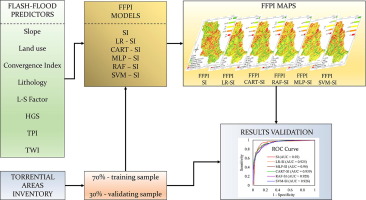当前位置:
X-MOL 学术
›
Sci. Total Environ.
›
论文详情
Our official English website, www.x-mol.net, welcomes your feedback! (Note: you will need to create a separate account there.)
Comparative assessment of the flash-flood potential within small mountain catchments using bivariate statistics and their novel hybrid integration with machine learning models.
Science of the Total Environment ( IF 9.8 ) Pub Date : 2019-10-08 , DOI: 10.1016/j.scitotenv.2019.134514 Romulus Costache , Haoyuan Hong , Quoc Bao Pham
Science of the Total Environment ( IF 9.8 ) Pub Date : 2019-10-08 , DOI: 10.1016/j.scitotenv.2019.134514 Romulus Costache , Haoyuan Hong , Quoc Bao Pham

|
The present study is carried out in the context of the continuous increase, worldwide, of the number of flash-floods phenomena. Also, there is an evident increase of the size of the damages caused by these hazards. Bâsca Chiojdului River Basin is one of the most affected areas in Romania by flash-flood phenomena. Therefore, Flash-Flood Potential Index (FFPI) was defined and calculated across the Bâsca Chiojdului river basin by using one bivariate statistical method (Statistical Index) and its novel ensemble with the following machine learning models: Logistic Regression, Classification and Regression Trees, Multilayer Perceptron, Random Forest and Support Vector Machine and Decision Tree CART. In a first stage, the areas with torrentiality were digitized based on orthophotomaps and field observations. These regions, together with an equal number of non-torrential pixels, were further divided into training surfaces (70%) and validating surfaces (30%). The next step of the analysis consisted of the selection of flash-flood conditioning factors based on the multicollinearity investigation and predictive ability estimation through Information Gain method. Eight factors, from a total of ten flash-floods predictors, were selected in order to be included in the FFPI calculation process. By applying the models represented by Statistical Index and its ensemble with the machine learning algorithms, the weight of each conditioning factor and of each factor class/category in the FFPI equations was established. Once the weight values were derived, the FFPI values across the Bâsca Chiojdului river basin were calculated by overlaying the flash-flood predictors in GIS environment. According to the results obtained, the central part of Bâsca Chiojdului river basin has the highest susceptibility to flash-flood phenomena. Thus, around 30% of the study site has high and very high values of FFPI. The results validation was carried out by applying the Prediction Rate and Success Rate. The methods revealed the fact that the Multilayer Perceptron - Statistical Index (MLP-SI) ensemble has the highest efficiency among the 3 methods.
中文翻译:

使用双变量统计数据及其与机器学习模型的新型混合集成,对山区小流域内的洪灾潜力进行了比较评估。
本研究是在世界范围内持续泛滥的现象泛滥的背景下进行的。而且,由这些危害引起的损害的大小明显增加。BâscaChiojdului流域是罗马尼亚遭受洪涝灾害影响最严重的地区之一。因此,使用一种双变量统计方法(统计指标)及其新颖的集合,通过以下机器学习模型,定义并计算了整个BâscaChiojdului流域的洪涝潜在指数(FFPI):逻辑回归,分类和回归树,多层感知器,随机森林和支持向量机以及决策树CART。在第一阶段,基于正射影像图和野外观察将洪流区域数字化。这些地区 再加上相等数量的非洪流像素,进一步分为训练表面(70%)和验证表面(30%)。分析的下一步包括基于多重共线性调查选择洪水条件因素,并通过信息增益法估计预测能力。为了从FFPI计算过程中包括十个洪水预报因子中选择了八个因子。通过将统计索引及其集成的模型与机器学习算法一起应用,可以确定FFPI方程中每个条件因子和每个因子类别/类别的权重。得出重量值后,通过覆盖GIS环境中的洪水预报变量来计算BâscaChiojdului流域的FFPI值。根据获得的结果,BáscaChiojdului流域的中部地区对洪水泛滥现象的敏感性最高。因此,大约30%的研究场所具有很高和非常高的FFPI值。通过应用预测率和成功率进行结果验证。这些方法揭示了以下事实:在三种方法中,多层感知器-统计索引(MLP-SI)集成具有最高的效率。通过应用预测率和成功率进行结果验证。这些方法揭示了以下事实:在三种方法中,多层感知器-统计索引(MLP-SI)集成具有最高的效率。通过应用预测率和成功率进行结果验证。这些方法揭示了以下事实:在三种方法中,多层感知器-统计索引(MLP-SI)集成具有最高的效率。
更新日期:2019-10-10
中文翻译:

使用双变量统计数据及其与机器学习模型的新型混合集成,对山区小流域内的洪灾潜力进行了比较评估。
本研究是在世界范围内持续泛滥的现象泛滥的背景下进行的。而且,由这些危害引起的损害的大小明显增加。BâscaChiojdului流域是罗马尼亚遭受洪涝灾害影响最严重的地区之一。因此,使用一种双变量统计方法(统计指标)及其新颖的集合,通过以下机器学习模型,定义并计算了整个BâscaChiojdului流域的洪涝潜在指数(FFPI):逻辑回归,分类和回归树,多层感知器,随机森林和支持向量机以及决策树CART。在第一阶段,基于正射影像图和野外观察将洪流区域数字化。这些地区 再加上相等数量的非洪流像素,进一步分为训练表面(70%)和验证表面(30%)。分析的下一步包括基于多重共线性调查选择洪水条件因素,并通过信息增益法估计预测能力。为了从FFPI计算过程中包括十个洪水预报因子中选择了八个因子。通过将统计索引及其集成的模型与机器学习算法一起应用,可以确定FFPI方程中每个条件因子和每个因子类别/类别的权重。得出重量值后,通过覆盖GIS环境中的洪水预报变量来计算BâscaChiojdului流域的FFPI值。根据获得的结果,BáscaChiojdului流域的中部地区对洪水泛滥现象的敏感性最高。因此,大约30%的研究场所具有很高和非常高的FFPI值。通过应用预测率和成功率进行结果验证。这些方法揭示了以下事实:在三种方法中,多层感知器-统计索引(MLP-SI)集成具有最高的效率。通过应用预测率和成功率进行结果验证。这些方法揭示了以下事实:在三种方法中,多层感知器-统计索引(MLP-SI)集成具有最高的效率。通过应用预测率和成功率进行结果验证。这些方法揭示了以下事实:在三种方法中,多层感知器-统计索引(MLP-SI)集成具有最高的效率。

































 京公网安备 11010802027423号
京公网安备 11010802027423号